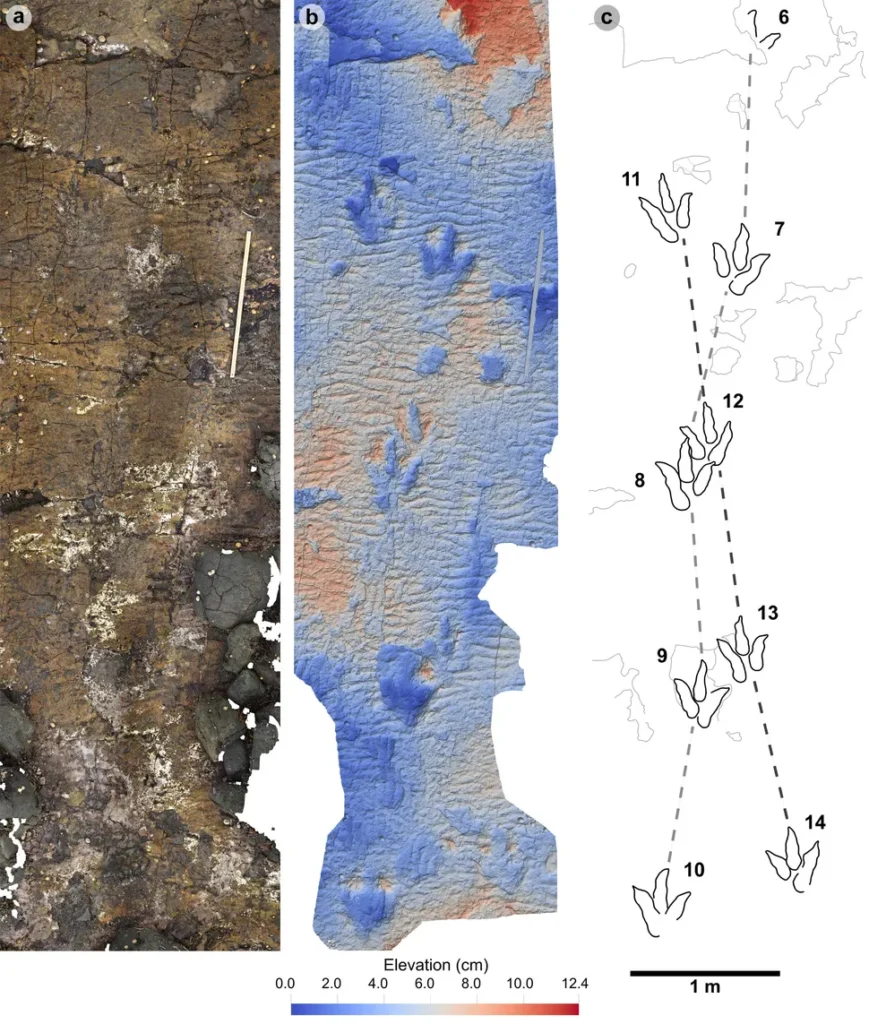Paleontologists have discovered tracks belonging to meat-eating theropods and long-necked sauropods on the Isle of Skye.
Ancient Footprints on the Isle of Skye Reveal Dynamic Dinosaur Activity in Prehistoric Scotland
Beneath the crashing waves of Scotland’s Isle of Skye, an extraordinary snapshot of Middle Jurassic life has been uncovered — 131 fossilized footprints belonging to long-extinct dinosaurs have revealed how giants once roamed the ancient lagoons of this remote island.
Published on April 2 in the journal PLOS One, the new research details a rich collection of trace fossils that date back to the Bathonian age of the Middle Jurassic period — approximately 168.3 to 166.1 million years ago. The site of the discovery, located on the island’s northeastern coast, is now named Prince Charles’ Point, a nod to Bonnie Prince Charlie (Prince Charles Edward Stuart), who is said to have landed there after his defeat at the Battle of Culloden in 1746.
But long before the prince’s ill-fated rebellion, this area was part of a lush and dynamic landscape inhabited by some of Earth’s earliest dinosaurs — a mix of fierce predators and gentle giants.
A Window into a Lost World
Unlike fossilized bones, which tell us what dinosaurs looked like, trace fossils — including footprints, trackways, burrows, and even coprolites (fossilized feces) — provide direct evidence of behavior. They capture fleeting moments in time: how an animal walked, ran, hunted, traveled in groups, or explored its environment.
The footprints discovered at Prince Charles’ Point were likely left in muddy sediment near the shoreline of a shallow lagoon, later preserved by unique geological circumstances. They include the distinct three-toed tracks of theropods (bipedal carnivores) and the broad, circular impressions of sauropods (long-necked herbivores). In total, the researchers identified 65 theropod prints, 58 sauropod prints, and 8 unidentified tracks.
“The theropod tracks even include well-preserved claw marks, offering rare anatomical detail,” said Tone Blakesley, the lead author of the study and a paleontology graduate student at the University of Edinburgh at the time of the discovery.
Diverse Dinosaurs on the Move
The researchers believe the prints belonged to dinosaur relatives of Megalosaurus (a meat-eating theropod that holds the distinction of being the first dinosaur ever named) and Cetiosaurus (a large sauropod), both of which lived during the Middle Jurassic.
Blakesley and their team identified four distinct types of theropod track, suggesting that multiple carnivorous species may have coexisted and frequented the same area — possibly even at the same time. However, distinguishing between the species based solely on footprints can be tricky, as similar foot shapes can produce nearly indistinguishable prints depending on conditions like stride, pace, and substrate.
Many of the trackways extended over 40 feet (12 meters) in length, with footprints ranging from 9.8 to 23.6 inches (25 to 60 centimeters) wide. Their irregular spacing and directionality suggest that the dinosaurs were milling — moving about without a specific pattern, perhaps foraging, exploring, or resting.
The Science of Preservation
What makes the Prince Charles’ Point site especially valuable is the clarity and quantity of the preserved tracks. Fossilized footprints are inherently fragile and are usually only preserved under ideal conditions. The prints here formed in a shallow, sandy lagoon, which was just strong enough to hold their shape. Soon after the dinosaurs walked across the sand, a storm or rising tide likely buried the tracks quickly with fine sediment, sealing them for millions of years beneath layers of rock.
“You would have to have a very quick burial of these footprints in order for them to be preserved so crisply,” Blakesley explained.
Even the ripples left by gentle currents in the prehistoric lagoon are still visible in the sandstone, providing a rare multi-dimensional view of the ancient environment.

An Evolving Dinosaur Landscape on Skye
The Isle of Skye has become a hotspot for Middle Jurassic fossils in recent years, with paleontologists unearthing both skeletal remains and fossilized footprints. This period in dinosaur evolution is globally underrepresented, making Skye’s findings incredibly valuable to the scientific community.
Earlier discoveries on the island revealed tiny dinosaur footprints, likely from hatchlings or juveniles, hinting at the possibility that the area once served as a dinosaur nursery. However, no such juvenile tracks were found at Prince Charles’ Point — these appear to represent adult or subadult individuals.

In a twist of scientific serendipity, the sauropod tracks at this site had previously been misidentified as ancient fish burrows in the 1980s. It wasn’t until the team’s 2019 expedition that a three-toed theropod footprint tipped them off.
“Just as we were packing up because the tide was coming in, we found a theropod footprint,” Blakesley recalled. “This is what happens in paleontology — you pack up and leave, then you find the best thing.”
Race Against Time
The discovery comes with a sense of urgency. The footprints are located in an intertidal zone, meaning they are regularly battered by waves. While these fossil traces survived for nearly 170 million years beneath layers of protective rock and sediment, now that they are exposed, they will inevitably erode.
Blakesley and their colleagues are calling for further documentation and preservation efforts. Capturing the tracks with 3D photogrammetry and digital modeling can help scientists preserve and analyze them long after they’ve disappeared from the shoreline.
“These traces are not just remnants of the past,” Blakesley said. “They are vanishing records of how dinosaurs lived, moved, and behaved in an environment we are only just beginning to understand.”
